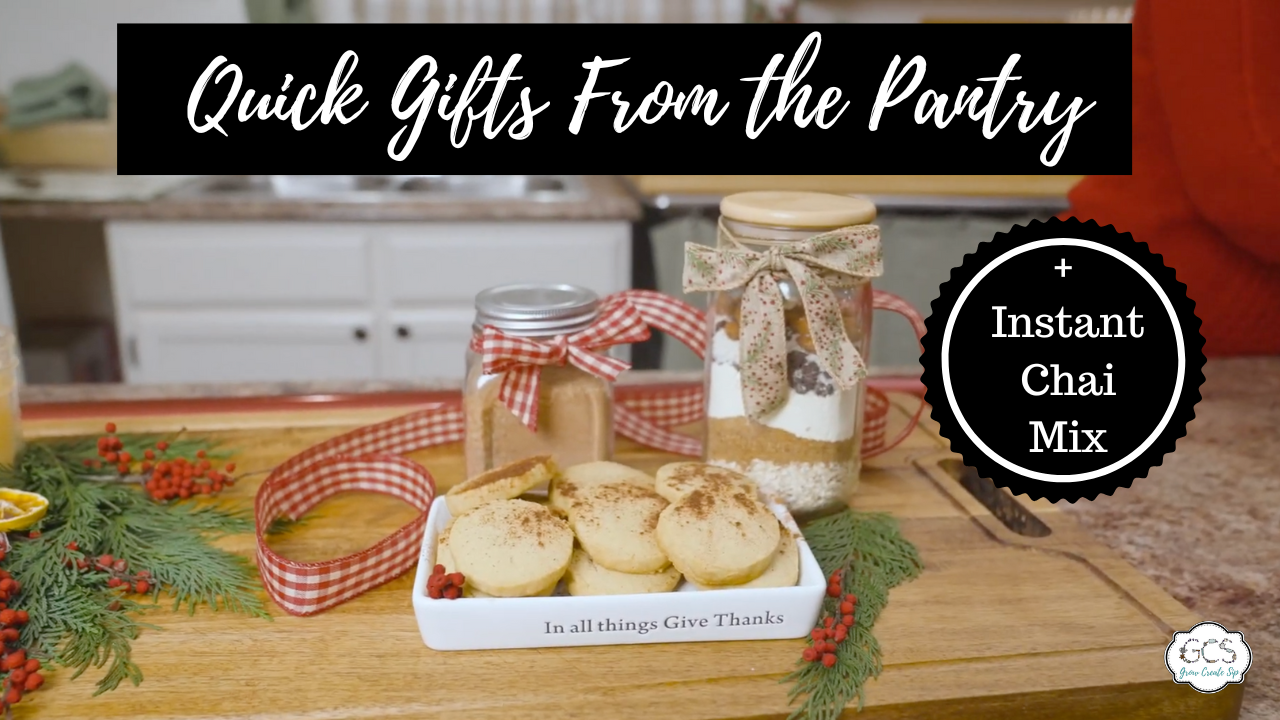How to Preserve Flowers for Tea
Aug 03, 2021
Have you ever wondered if those rose petals or other flowers in your yard were useful? Or wondered what flowers are edible flowers? If you are like me, you can’t wait to see what other fun ways there are for making those colorful beauties in your yard last longer and how to make them even more useful.
While we teach how to dehydrate flowers in our Herbal Studio community, and how to store herbs here on the blog, we have never really dived in deeply on how to preserve flowers for tea. Like these beautiful ones in our Rose Garden Repose Tea.
Wait no longer my herb and tea-loving friends because I’m going to dive deep into this post on why drying flowers is one of the best ways to preserve flowers for tea, what to do with dried flowers once you have them, and other ways to preserve flowers.
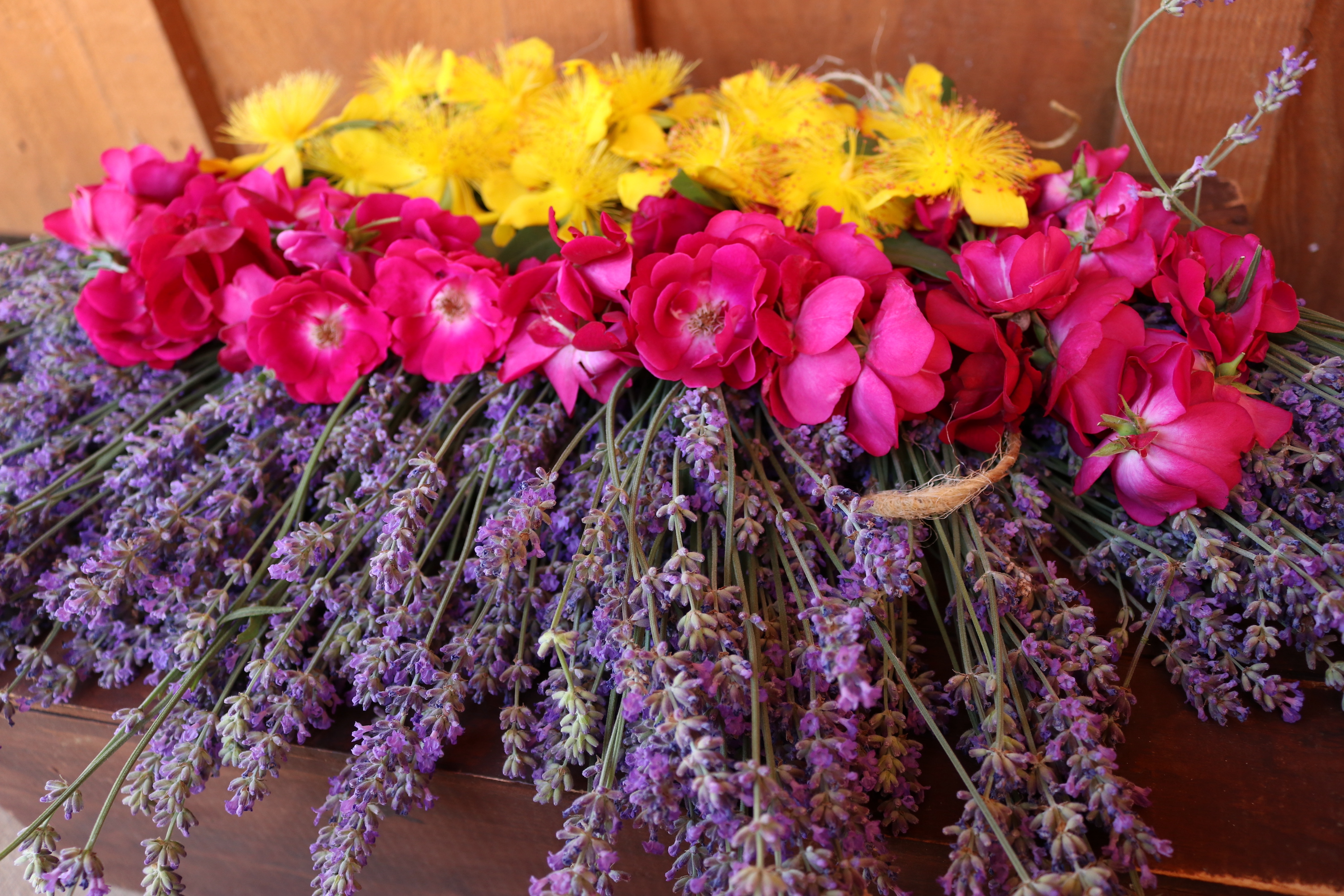
How to Preserve Flowers
There are so many different ways that you could preserve flowers such as letting them dry in a bowl full of sugar and then later using them on cakes or cookies. Pressing them in books, infusing them into a glycerine or alcohol for a tincture or drink flavoring, using a sand or sugar method, you can freeze dry, air dry, and even dry them in the microwave (though I’m not a microwave fan here). Using natural flowers in crafting or in herbal creations is a great way to add beauty and color to your creations.
Let’s talk about some different drying methods though, my favorite drying method being either air drying and/or machine dehydrating!
How to Dry Flowers
One of the most affordable ways to dry flowers is with air drying. It doesn’t involve needing to buy an electric dehydrator right off the bat and it is great for small batches of flower petals. Air drying is very similar to hang drying in that they use the same form of air control, but a different space to dry on.
Let’s start with how to air dry things like flower petals: pluck and place on a dry surface like a paper towel or butcher paper and let dry at room temperature until crisp. If desired, cover with another light paper towel to keep bugs and dust off, as well as little hands that might be around.
There are also some hanging air dryers that might come in handy and save space if your harvest becomes larger than the flat surface you have available for drying them on. These hanging air dryers are multiple layers and can hang from just about anything such as a hook in the ceiling or a curtain rod in the living room. They provide plenty of airflow for the flower petals and keep the bugs out. We have one similar to this one here on Amazon.
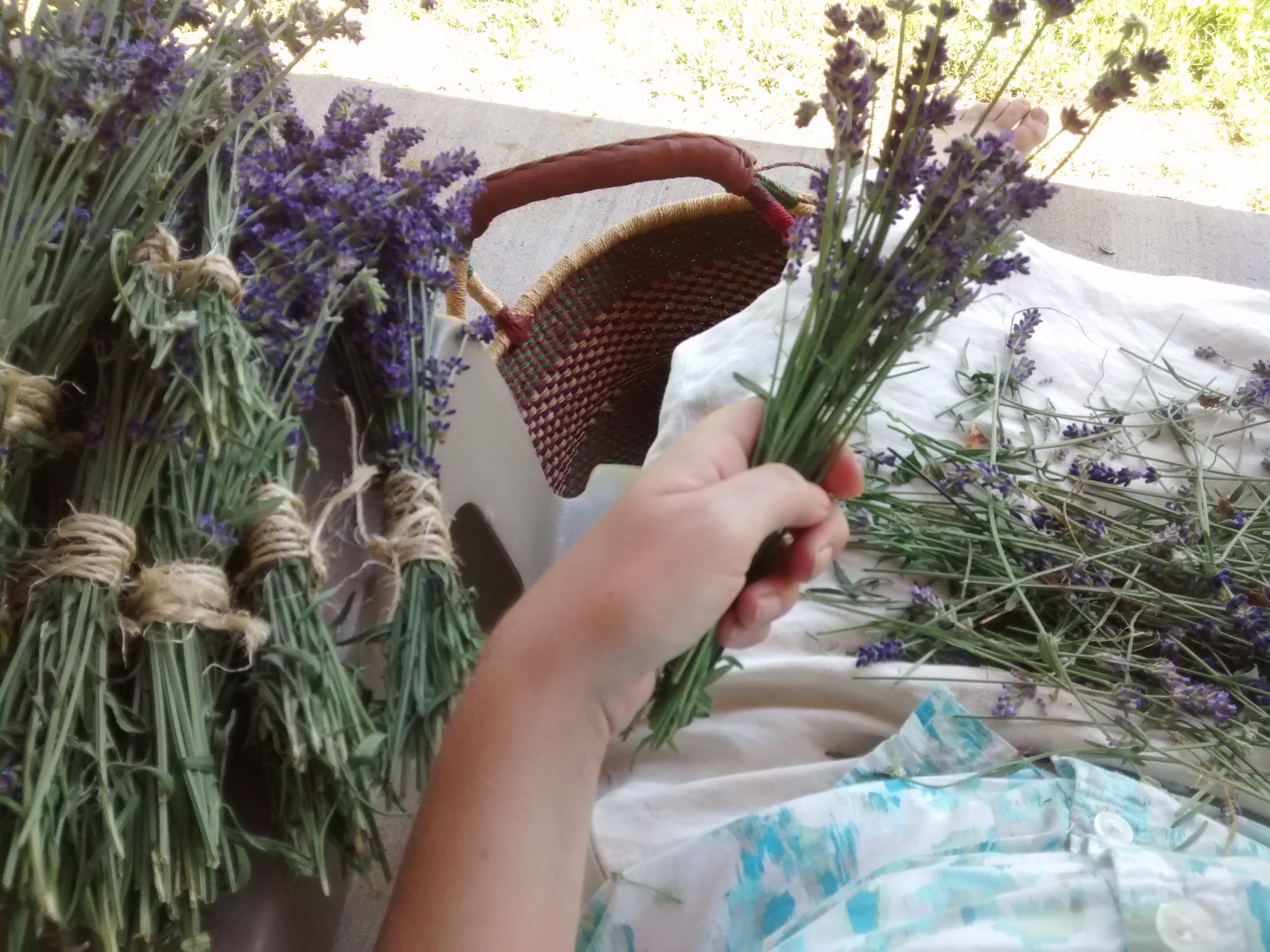
Hang Drying Flowers
Another method of air drying flowers is to hang dry them. This is a super simple way to do large bunches of flowers at one time, especially if they are still on the stem such as lavender. Simply take the bundle of flowers and using a string or rubber band tie them tightly about midway between the bottom of the flowers and the bottom of the stems. Cutting long stems for this method is best.
Once they are tied with a string or rubber band hang them upsidedown and tie them from a curtain rod, shelf, or another place. Make sure the flowers are sort of fanned out so that they get plenty of airflow around them. Otherwise, they may not dry well or evenly and could mold.
If you are worried about dust getting on these just put a brown paper bag over the flowers before you use the tie or rubber band and then hang as usual. The paper will soak up any moisture and keep the bugs off of your flowers!
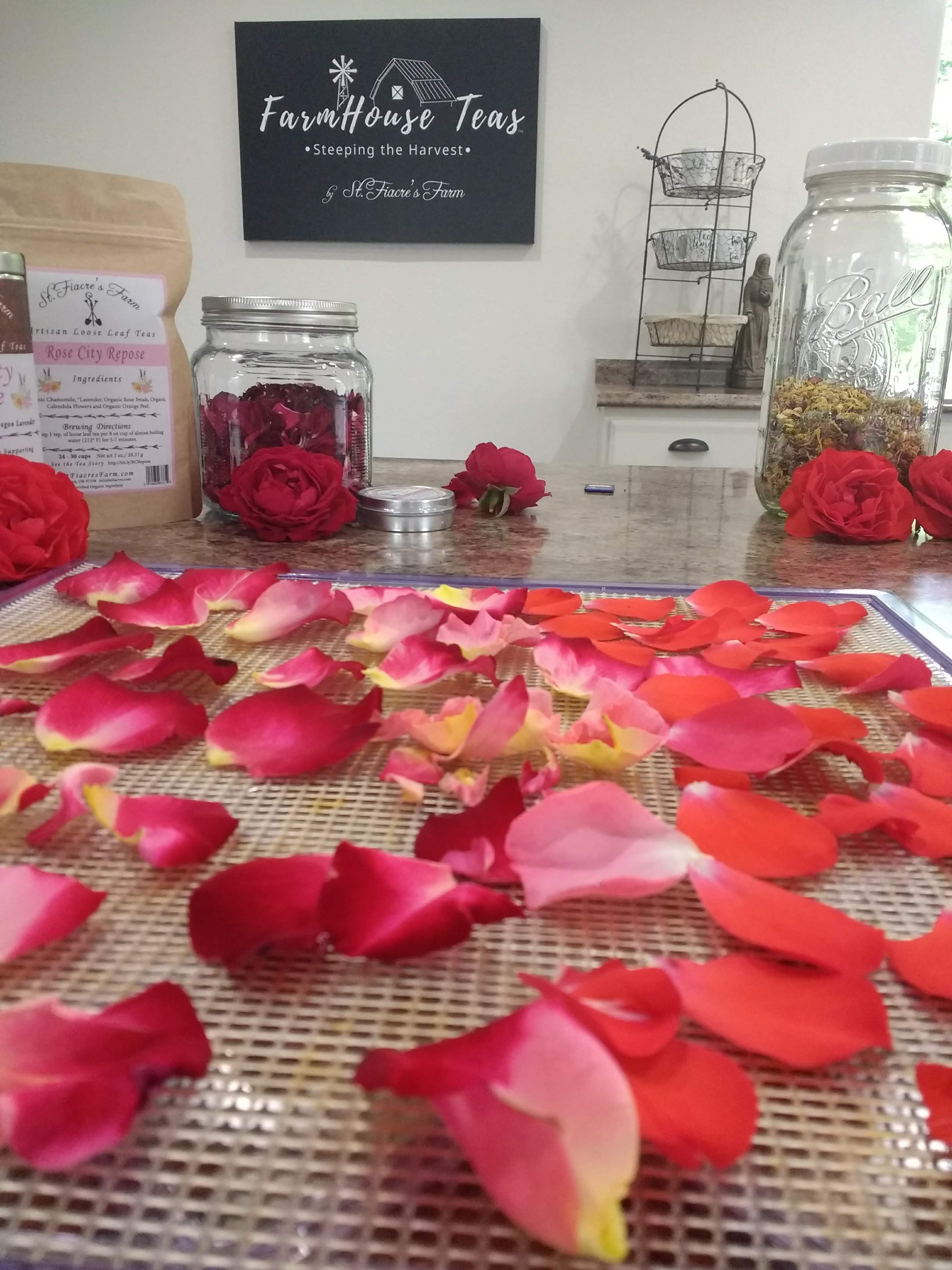
Dehydrating Flowers
My absolute favorite way of dehydrating flowers is to use an electric dehydrator. They are faster, more consistent, and time-saving. I don’t have to worry about what flat surface my air-dried flowers are sitting on or about dust getting on them in the hanging air dryer.
I can also make sure that I get all of the harvest done as fast as possible so flower petals that are waiting to be done are not going bad. Make sure to check out our tips here on how to select the best dehydrator for your flowers, fruits, and roots when making herbal teas.
While we do a lot of berries here on the farm for tea, we do not actually grow as many berries as we do flowers. Edible flowers provide not only medicinal properties to some of our teas, but they are beautiful to boot. There is nothing like a pop of color from flower petals to bring an herbal tea to life.
There are so many edible flower options! Marigolds, bachelor button or cornflowers, chicory flowers, rose petals, calendula, sunflowers, nasturtiums, poppies, elderflowers, echinacea, and the list goes on and on. The trick here though is being able to sacrifice the beauty in the yard to the dehydrator!
How to Dry Out Flowers Using Other Methods
Aside from dehydrating whether you decide to air dry, hang dry or machine dry. There are different methods of preserving flowers.
- Heavy Book- This is a very old traditional method for drying out flowers. Take the flowers you want to dry out and place them between the pages of a heavy book. Leave them for several days or weeks until they are dried out.
This creates delicate flowers that can be used for things like pressing into shortbread cookies, adding to stationary when paper making, decorating homemade cakes with and so many other wonderful things!
- Sand- Dry the flowers in a bowl full of sand. This method works best when using flowers for a craft. Beware that you might have bits of sand left on your flowers. When dried and preserved you may even try silica sand to preserve them with.
- Sugar- Similar to the sand method the sugar will draw out the moisture from the flowers and then the flowers will be preserved for some time. These would be great to use on cakes, cupcakes, sugar cookies, and any edible item as a natural flower edible decoration.
- Microwave- While this microwave safe method can be used I don’t recommend it. There is plenty of research (thank you Mr. Google) showing that microwaving food causes it to lose its nutritional value. Microwaving is also a finicky drying method involving a few seconds here and a few there otherwise you may have just toasted your flower petals.
Once you pick your drying method of choice, how in the world do you tell if they are completely dry?
Dried flowers are completely dry when they are almost crisp, there is absolutely no moisture left in them (unless using the sugar method) and they are slightly flexible or crispy. Moisture is the enemy of dried goods my friend. Once you have them dried make sure you store them well before use. For tips on how to do that read The Best Way to Store Herbs.
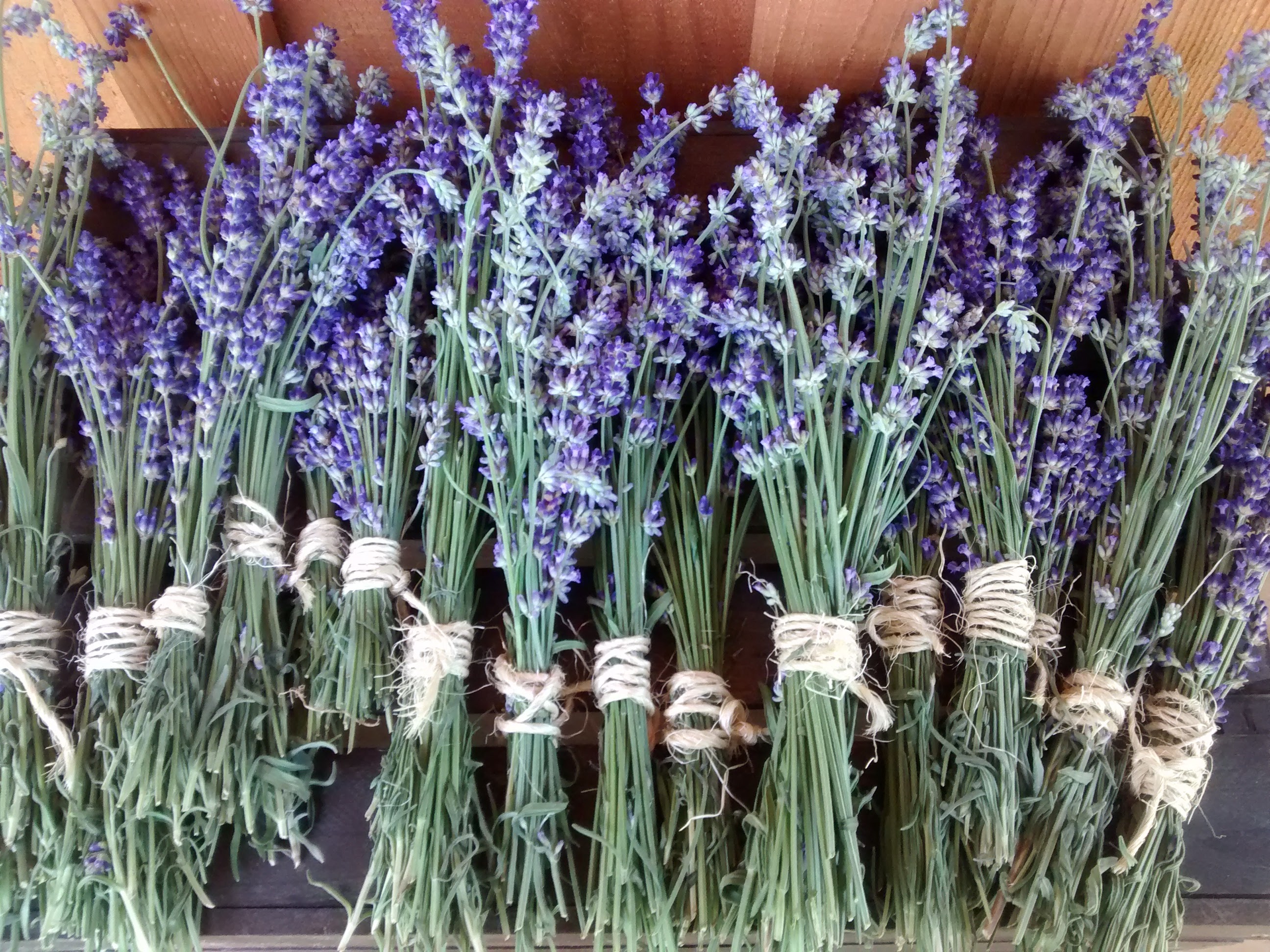
Dried Lavender
The health benefits of lavender are many and also well known, from aiding in relaxation and stress relief to keeping those pesky moths out of your dresser drawers as well as making a fabulous calming cuppa tea.
While lavender essential oil is probably one of the most well-known uses for lavender flowers, we are going to focus on the dried lavender buds here for making herbal tea.
Dried lavender pairs well with so many other flavors from chocolate to roses, to chamomile and so many other flowers. Don’t forget the famous lavender earl grey tea pairing. Whatever tea blend you decide to add your dried lavender to, it’s great to have on hand.
My favorite way of drying lavender is usually by using the hang-drying method. Often lavender is ready all at once and harvested in giant bundles. This makes it ideal for tying with twine or using a rubber band. Then just hanging them in the cleanest, warmest dry spot in the house.
When the lavender has dried I strip the stems by hand and clean out any of the unwanted bits. We then have dried lavender for days to add to so many of our teas like La Creme De La Crop Grey and Lavender Lemon Chiffon!

Dried Calendula
Calendula flowers are also known as calendula officinalis. This is by far one of my favorite flowers as it got me started on my herbal medicine journey that eventually led to this blog here as well as creating our blends at Farmhouse Teas. It’s hard not to smile at this bright yellow sunshine flower.
Calendula flowers have many health benefits as well. Calendula really shines when it comes to skin and I mean that quite literally. It’s fabulous for making your skin glow as well as for taking care of cuts and scrapes and dry heels. Take an in-depth dive into the health benefits of calendula by checking out our 4-page herbal monograph in the Herbal Studio & Communi-tea.
Calendula grows almost like a weed and prefers a bit of neglect. Don’t overwater this flower but make sure to harvest it often and it will continue to give you its beautiful yellow blossoms. My preferred method for drying sizeable batches of calendula flowers is to use the electric dehydrator.
I turn these flowers upside down while they are open with the stem part up. When calendula are done drying they will be a bit tacky due to their natural resins and oils. No worries though they will still get pretty crispy and you will know when they are done.
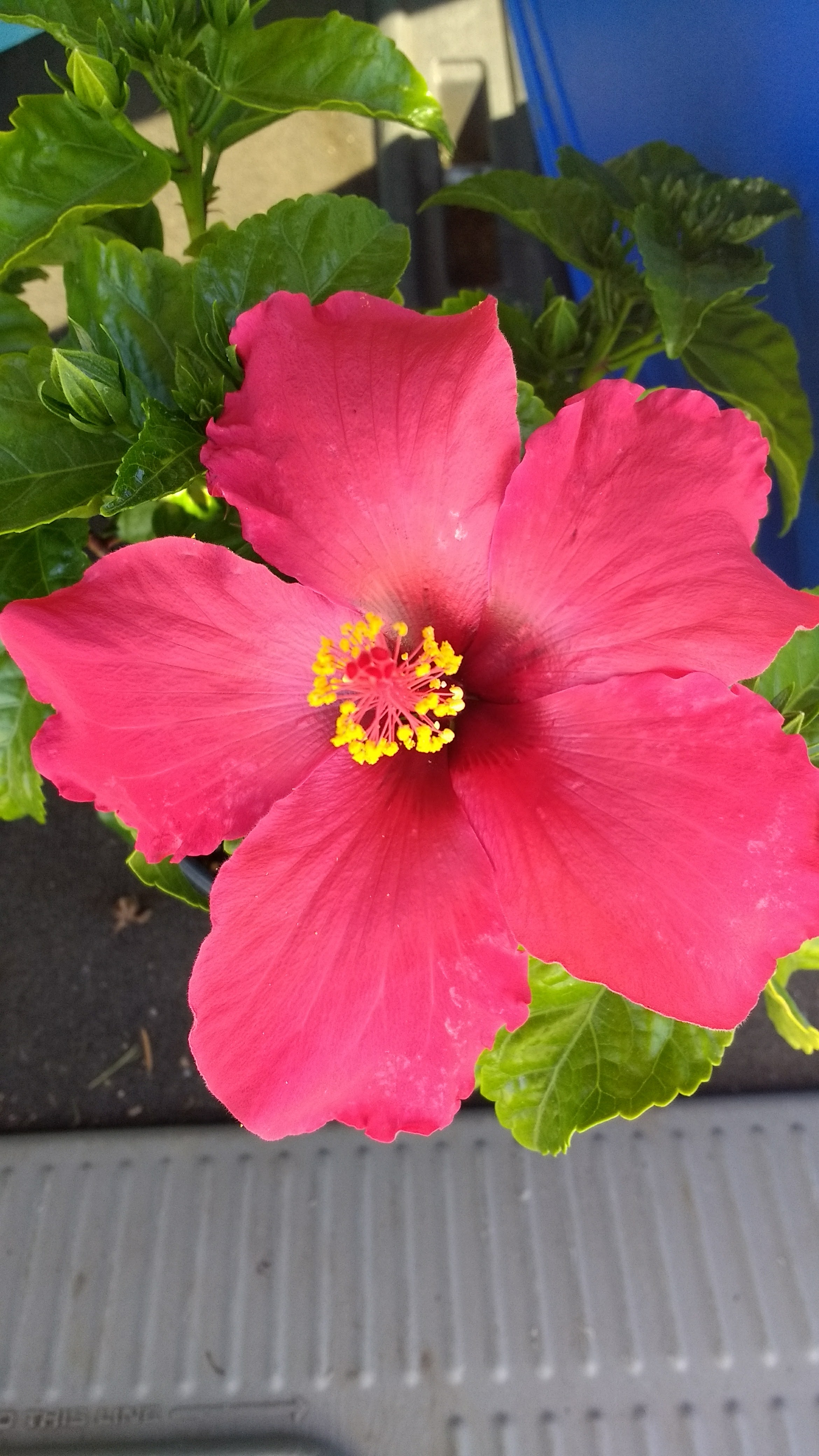
Dried Hibiscus Flowers
Dried Hibiscus flowers make fabulous Agua de jamaica a.k.a. Hibiscus iced tea. We drink plenty of it here on the farm in the summertime in the form of High Desert Hibiscus. It’s fabulous with some honey and even pairs well with lemonade.
Hibiscus health benefits really shine when it comes to the heart and the blood. It’s a great way to lower blood pressure, but also be careful if you struggle with low blood pressure. Hibiscus tea may not be the one you want to be grabbing very often.
Hibiscus is a tropical flower and so not a common one that everyone will be able to grow. It’s commonly mistaken (and the common name is to contribute to that mistake) that the flower of the hibiscus is used when it is actually the calyx.
The calyx is the pod that is left behind when the hibiscus flower dies off much like the pod of an okra plant. These pods can be dried whole and I recommend an electric dehydrator for consistency and time. The pods can also be broken into smaller pieces before dehydration for ease of use.
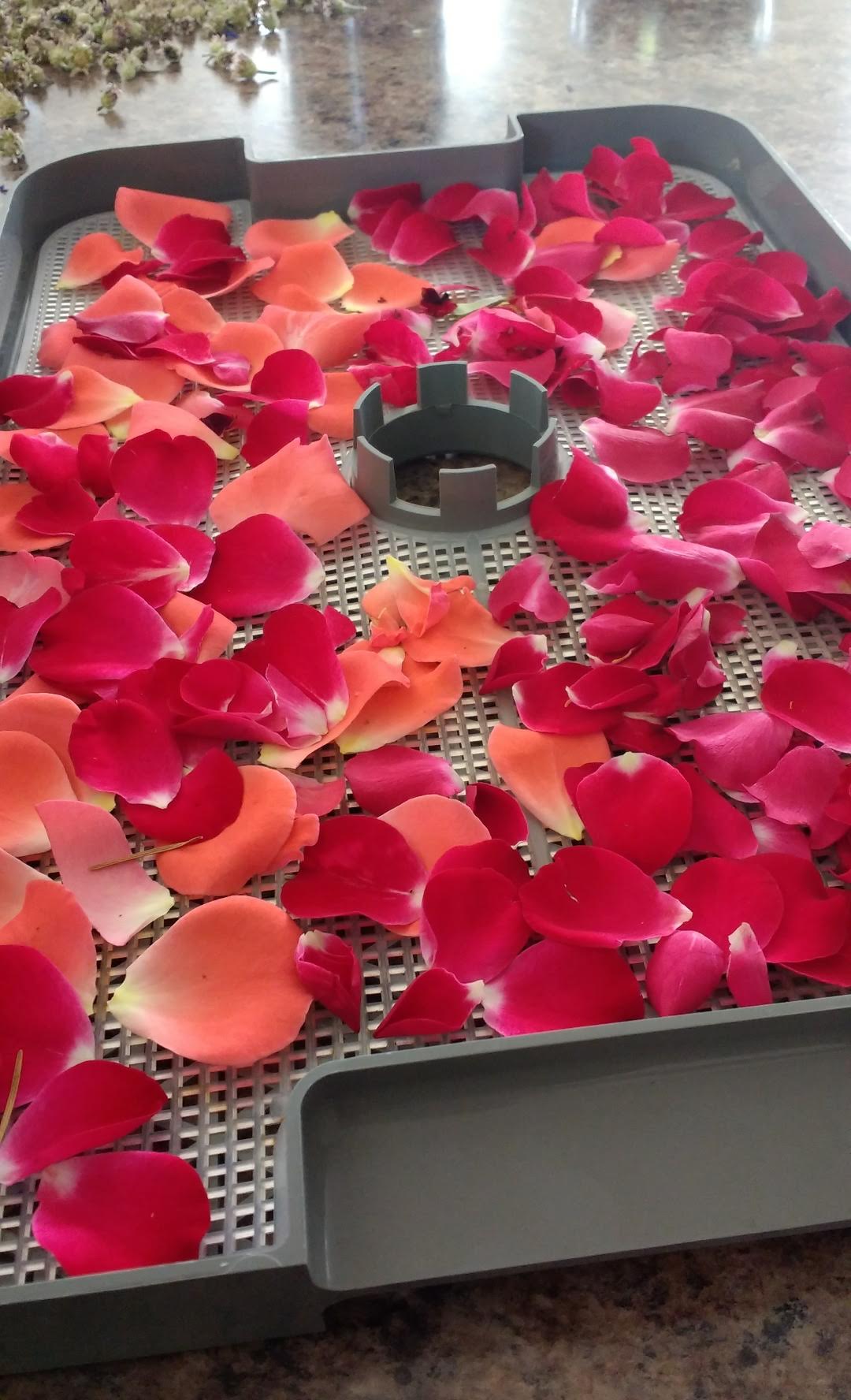
Dried Rose Petals
Dried rose petal tea is very popular especially in Bulgaria where they grow so many roses. Rose petals have many great medicinal properties and health benefits. They shine especially when it comes to depression and you need one good cheer-up cup. Roses are great for the heart as well. Is it any wonder why people give roses to loved ones or send flowers when people are down? They don’t just look pretty and lift the mood but they taste great too!
While any unsprayed roses are great to use and edible, not all of them have the best flavor. The Rosa Rugosa and Damask Roses are usually the favorites when it comes to preserving rose petals for tea. Some roses may have too much of a perfume scent to be a favorite for tea blending but the flavor is all up to you. I’m certainly a fan of using what you already have available to you.
Just make sure those roses have not been sprayed with chemicals at any point in their existence. Most of those sprays have a long half-life that isn’t going to leave your plant. Organic unsprayed roses are best when it comes to drying edible flowers!
Rose petals can be air-dried or machine dried, I make that call based on how much of a harvest I have at one time. The petals can stay intact on the flower head or they can be pulled apart and dried singularly.
The decision is up to you and what you want the end product to be. Full-headed roses will take longer to dry and if air-drying make sure to turn them upside down on a paper towel of another dry surface. The full head can also go in the electric dehydrator and is probably the better option. If drying rose petals pluck them from the head and lay them out on a paper towel, air dehydrator, or electric dehydrator. They will be done when crispy, but don’t burn them!
How Long to Dried Flowers Last
When it comes to making your dried flowers last first to make sure you are storing them in the best way possible. Generally, dried herbs, including flower petals will last 18-24 months and then they will deteriorate over time losing their medicinal properties, color as well as flavor. It really will depend on each flower individually though as well as how the dried flowers are stored.
Some dried hydrangeas that are kept in a vase in the house take on a lot more sunlight, dust, and air than some rose petals that are stored in a mylar sealed bag in cool storage. Use your nose and your eyes to tell you if your dried flowers are still good or not. If you really wanted you could ad silica gel packets to your dried flower stash but I don’t see that as necessary unless you are preserving them for a really really long time.
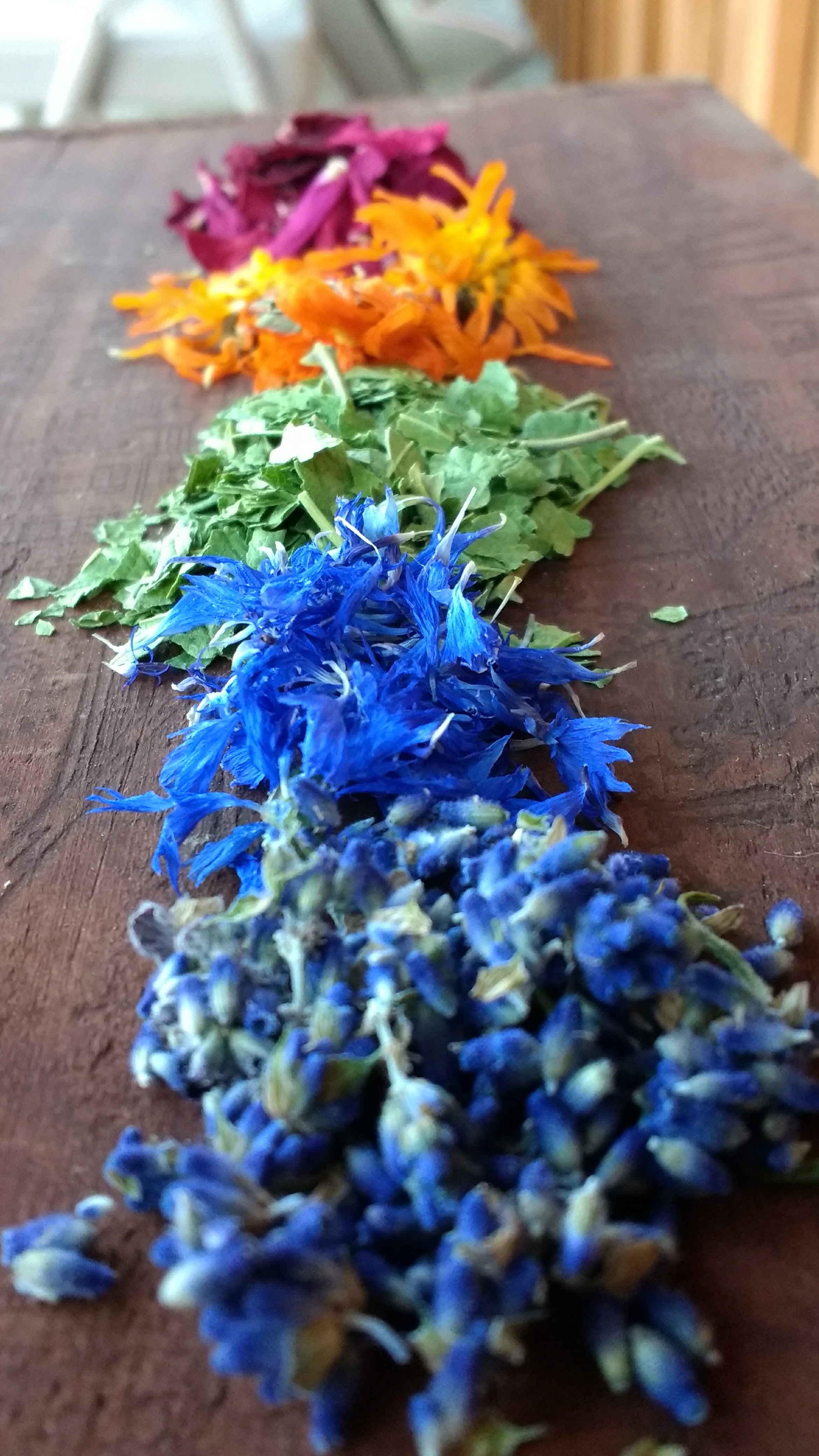
What to do with Dried Flowers
Deciding what to do with your now harvested and dried flowers really depends on several things. What kind of flowers you have, what quantity of flowers you have, if you are wanting to create something crafty and beautiful or if you are looking at an edible creation. I’ve got some ideas for you though!
- Bath Salts
- Decorating cakes
- Topping Shortbread
- Flavored Sugar
- Dried Flower Bouquets
- Floral Wreaths
- Framed Flower Art
- Perfume
- Potpourri
- Bath Teas
- Edible Flower Confetti
- Herbal Teas
- Black Teas
- Green Teas
- Freezing in Ice Cubes
- Adding to Ice Cream
- Pressed Flower Ornaments
- Epoxy Resin Jewelry

Flowers for Tea
Here on the farm many if not most of our flowers make their way into herbal tea. Not only are the flowers a beautiful addition to the tea blend, but some of them add medicinal values and flavor to the tea as well. Here are just a few of our blends that use dried flowers to give you some ideas of what you can do with them:
Creme De La Crop Grey Black Tea- A black tea featuring hibiscus flowers and lavender to make a Lady Grey sort of blend. Deep dark rich earl grey with the slightly tart hibiscus tea and floral lavender hints. This is a great way to blend florals with black tea.
Rose Garden Repose Herbal Tea- One of our customer’s favorite nighttime teas for helping with stress and relaxation is 99% dried flowers including calendula, chamomile, rose petals, lavender, and just a hint of orange peel to create a relaxing floral tea.
Sugarbush Blueberry Roobios Herbal Tea- A blueberry tea with creamy vanilla like rooibos but the thing that makes this blend beau-tea-ful is the rose petals.
Harvest Berry Herbal Tea- Try this house blend from Farmhouse Teas, it was made with all the flavors of the fall season. A base of blackberry leaf, Aronia berries, apples, and blue bachelor button flowers for color. It’s been said it tastes like a blackberry cobbler in a cup!
There are so many more ways to use flowers for tea and these are just a very few. You are only limited by your imagination and the flowers that you have on hand. I can’t wait to see what you create! If you would like to learn more about blending medicinal teas with dried flowers make sure to check out our free tea blending workshop here. A deep dive on many of these edible flowers is also available in our Herbal Studio & Communi-tea membership area.

Would you do me a favor?
Leave me a comment below and share with me either creations you have already made with dried flowers and or tea blends that you plant to make with edible dried flowers.
Related Posts
- How to Dehydrate Chickory Root
- Best Food Dehydrator for Dehydrating Herbs
- Best Ways for Storing Dried Herbs
- How to Dry Herbs Without a Dehydrator
- Health Benefits of Kombucha (Fermentation)
- Sweet Hibiscus Tea Lemonade (Fermentation)
- 10 Herbs to Grow for Tea










